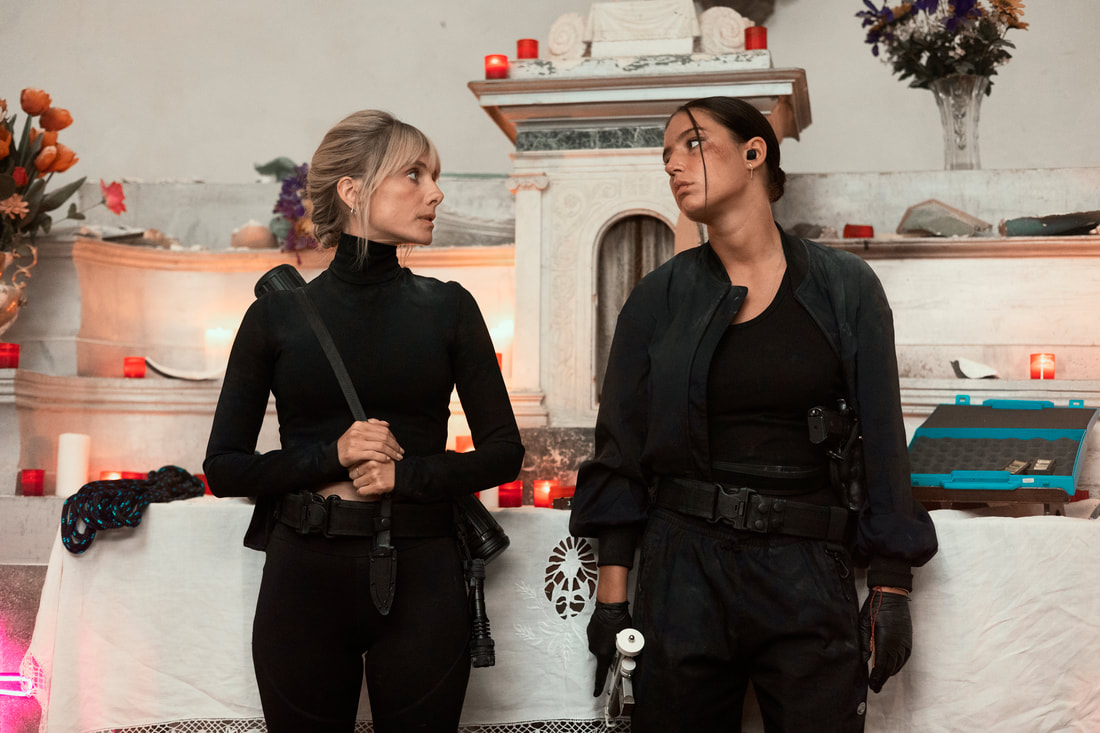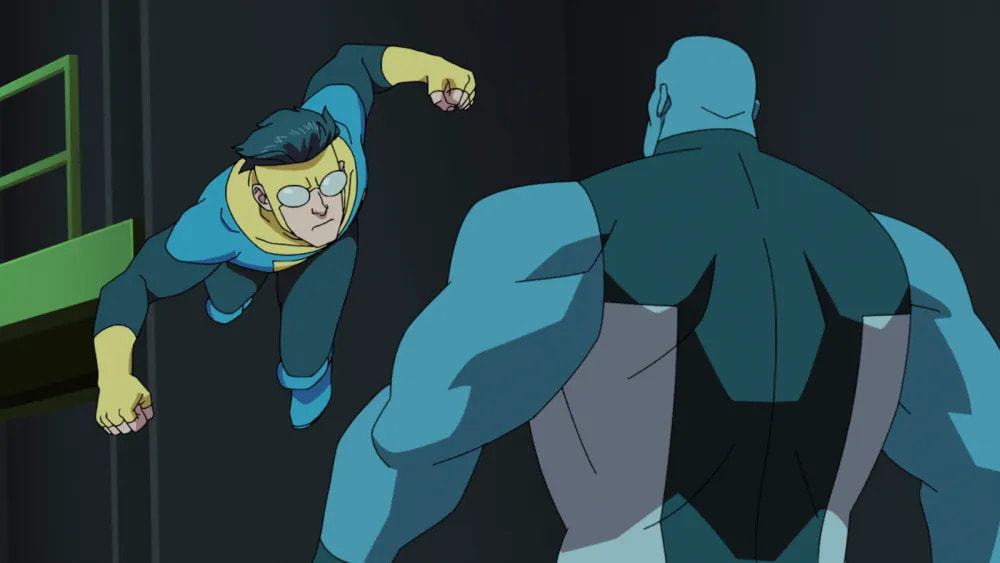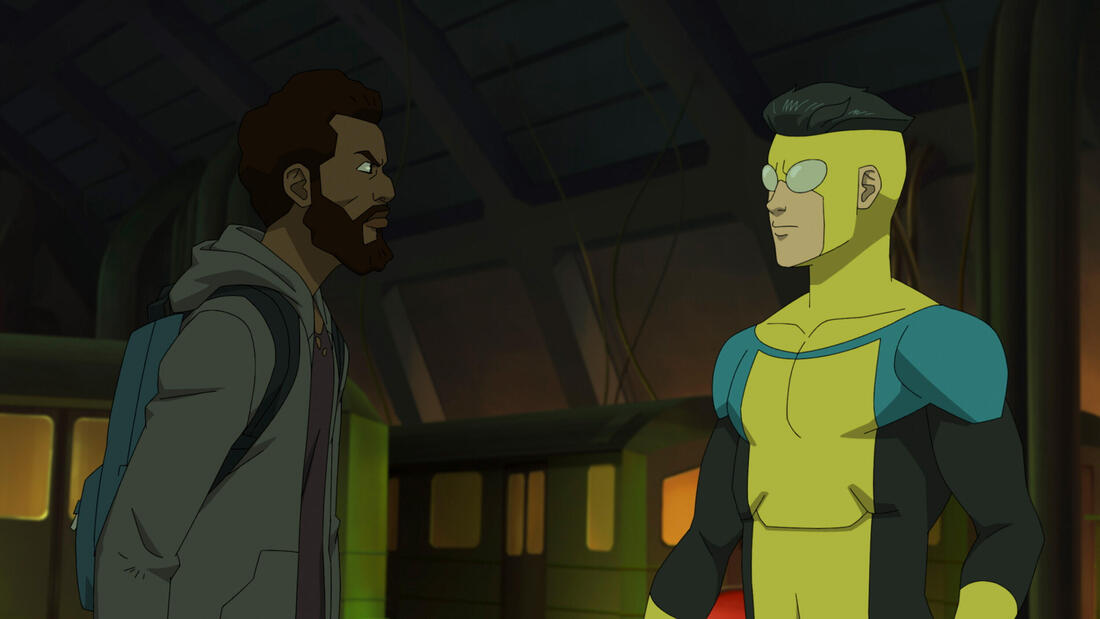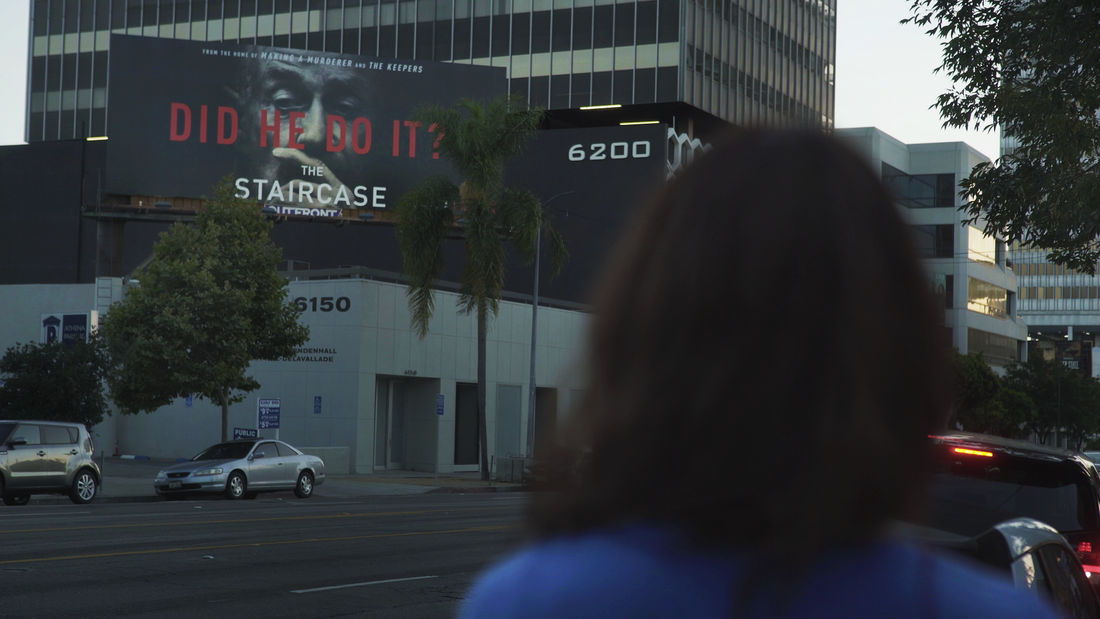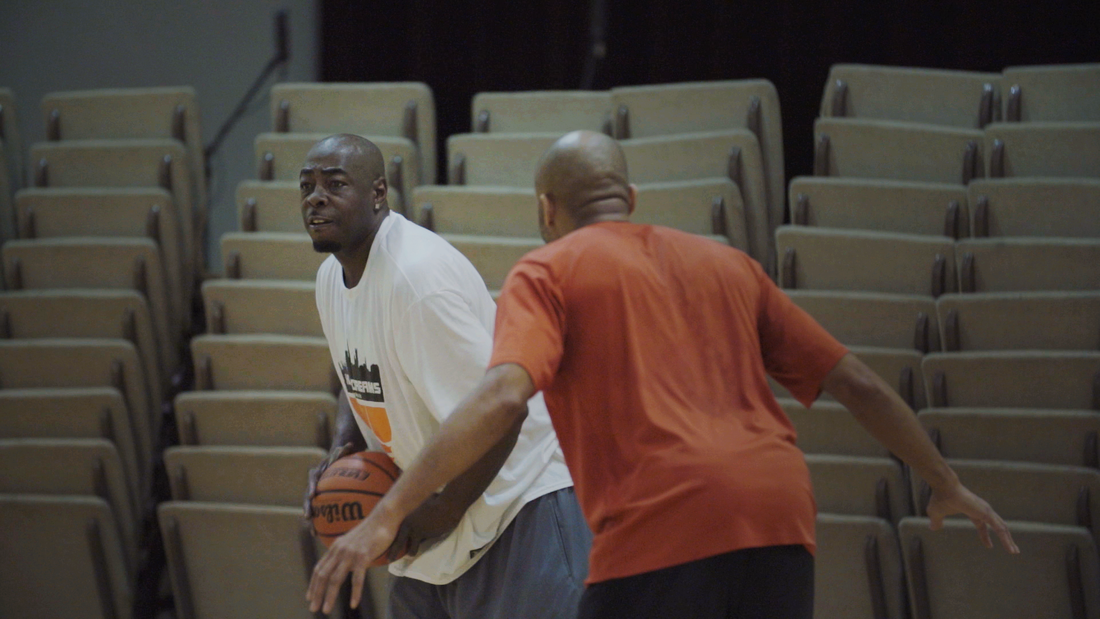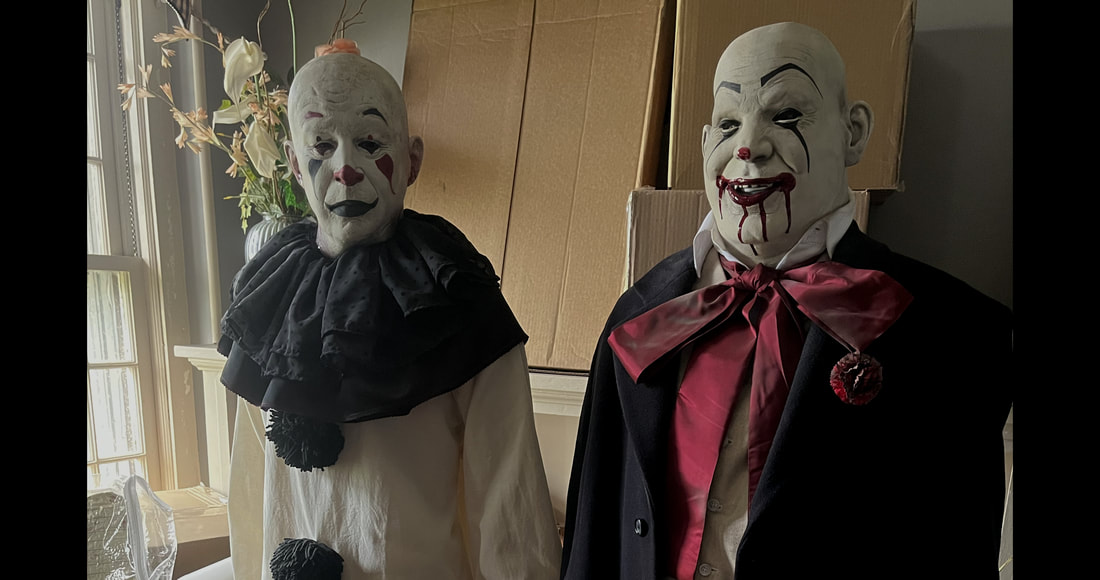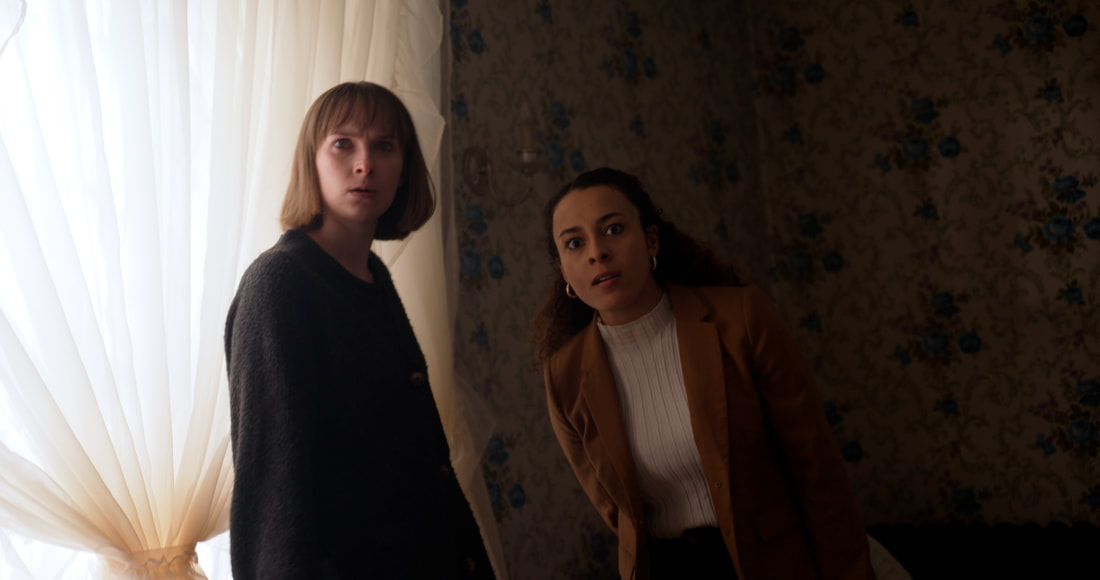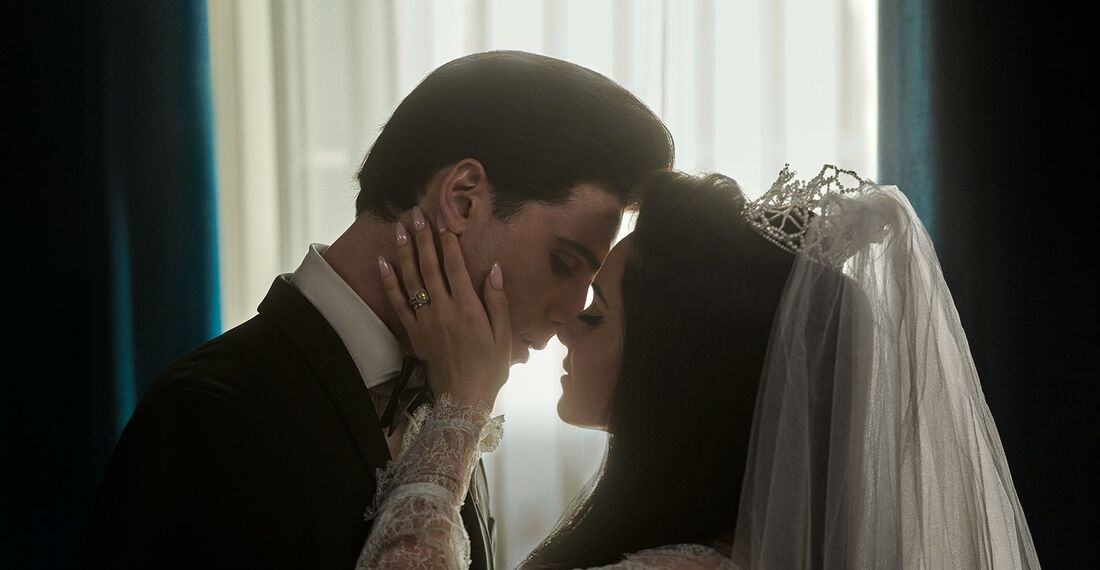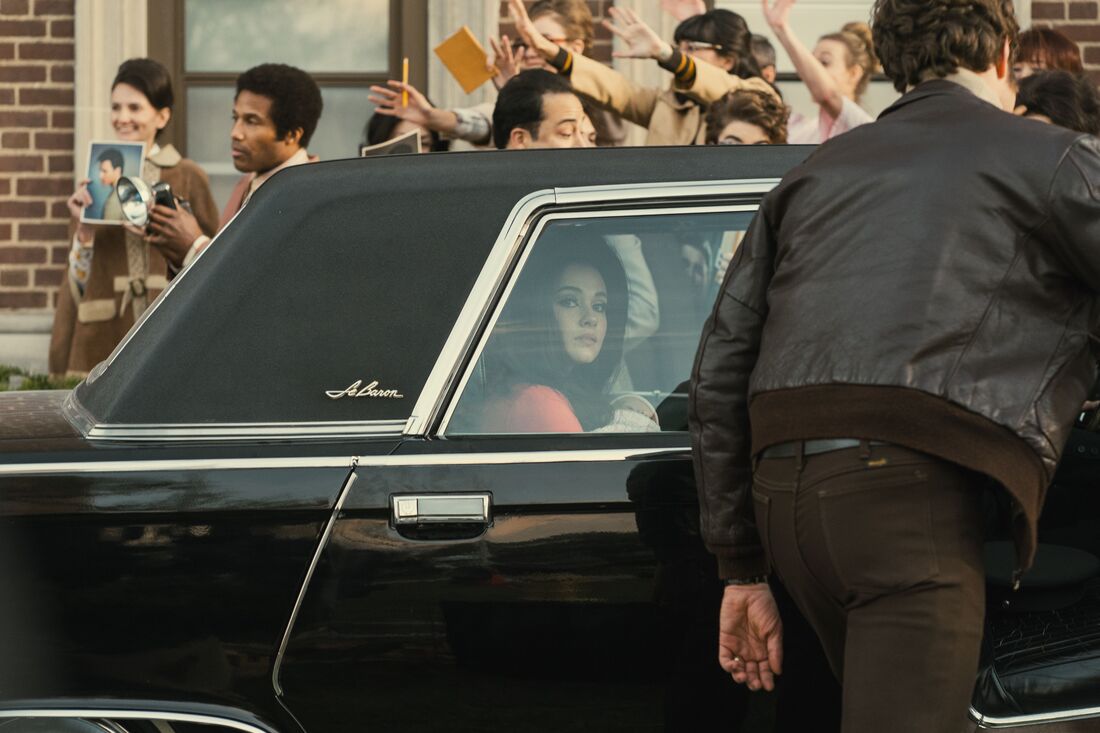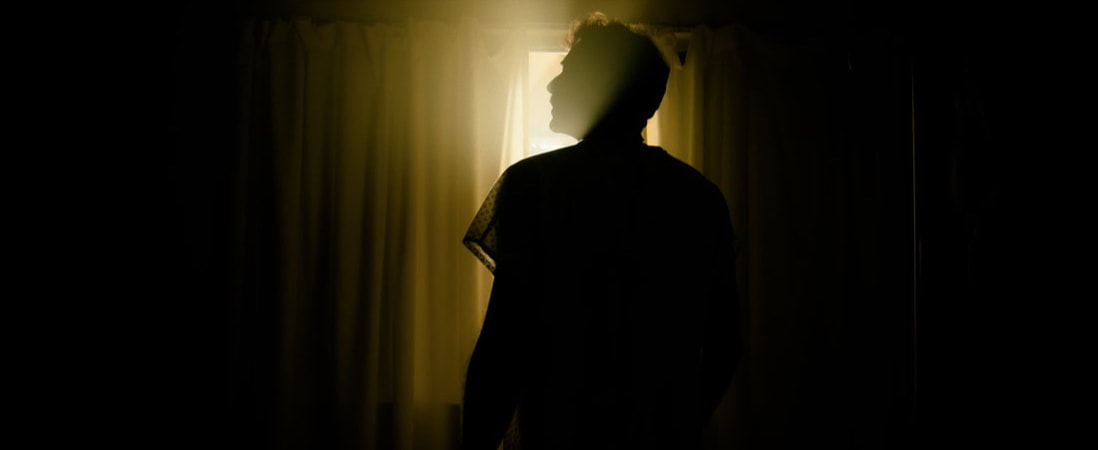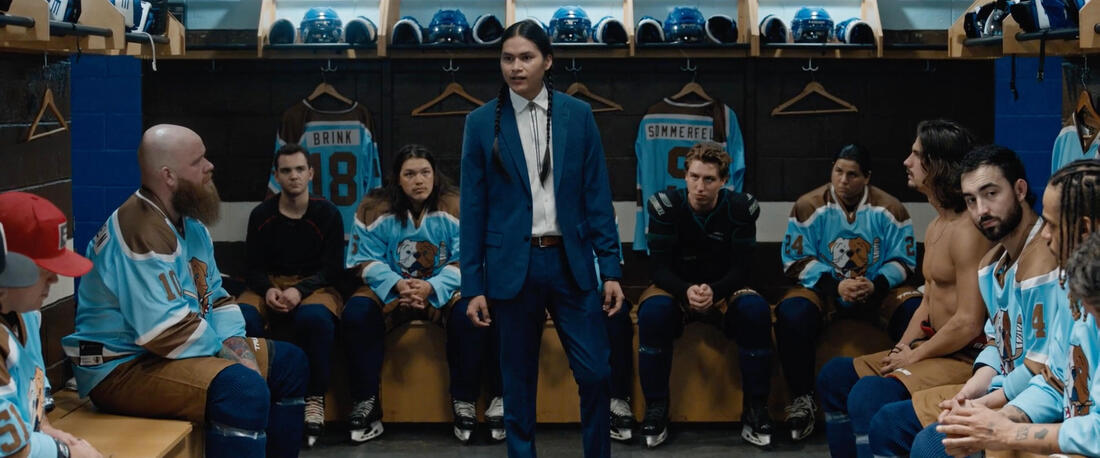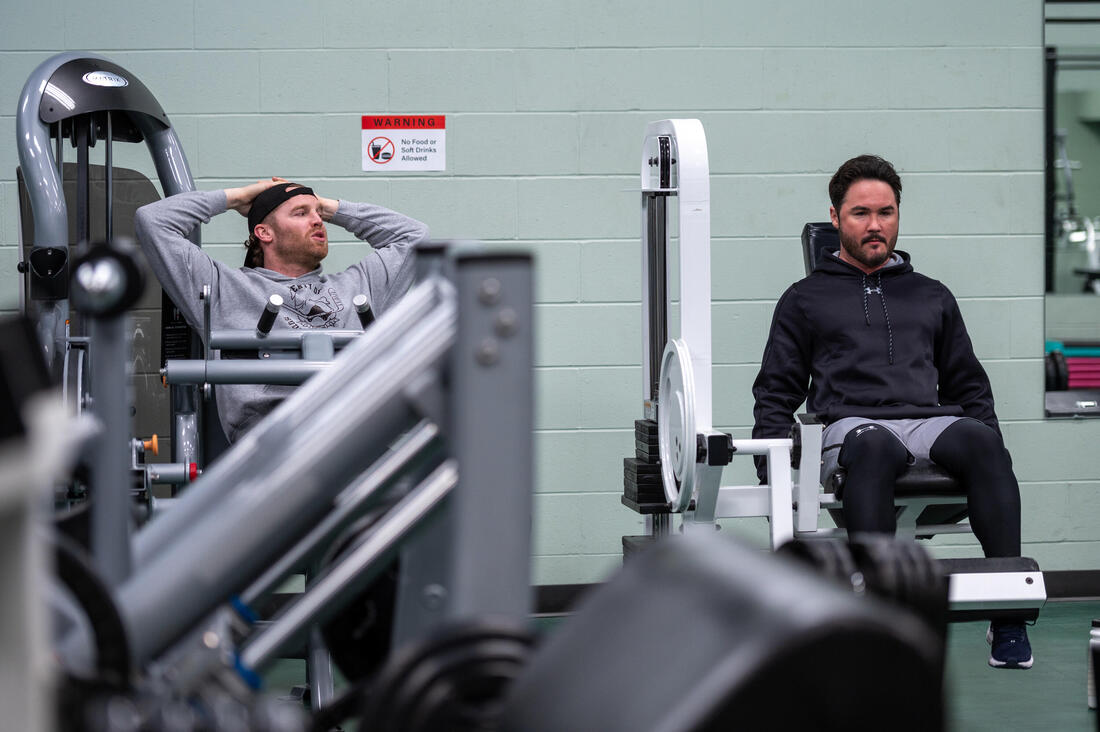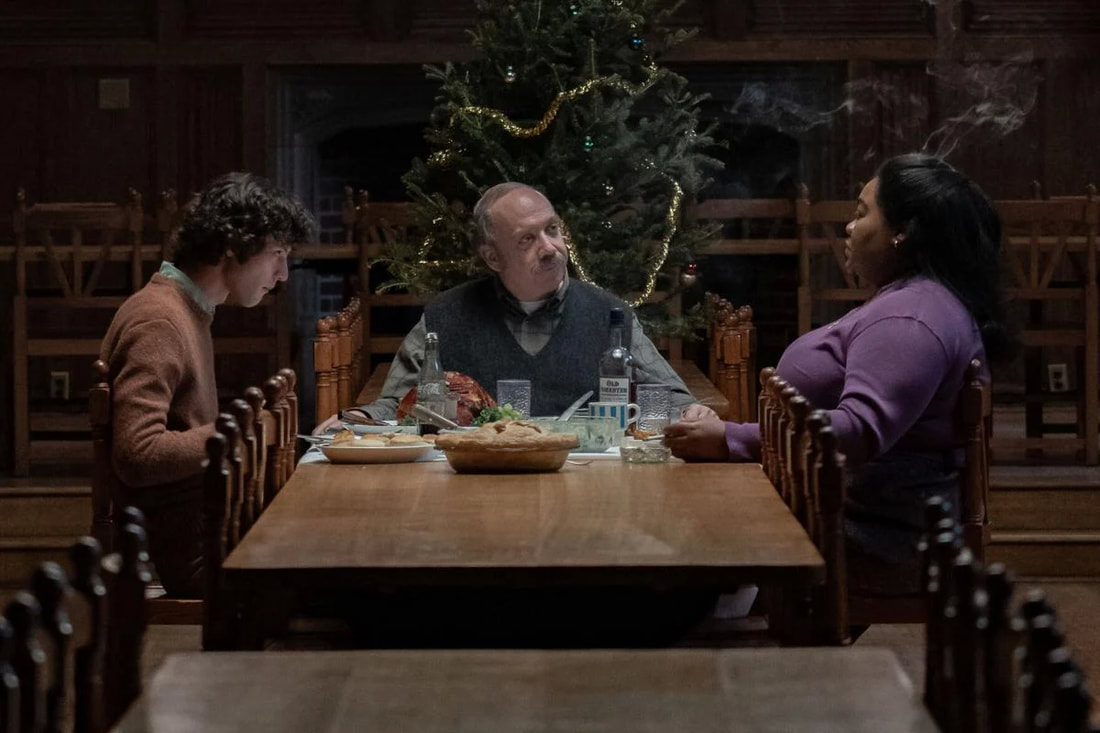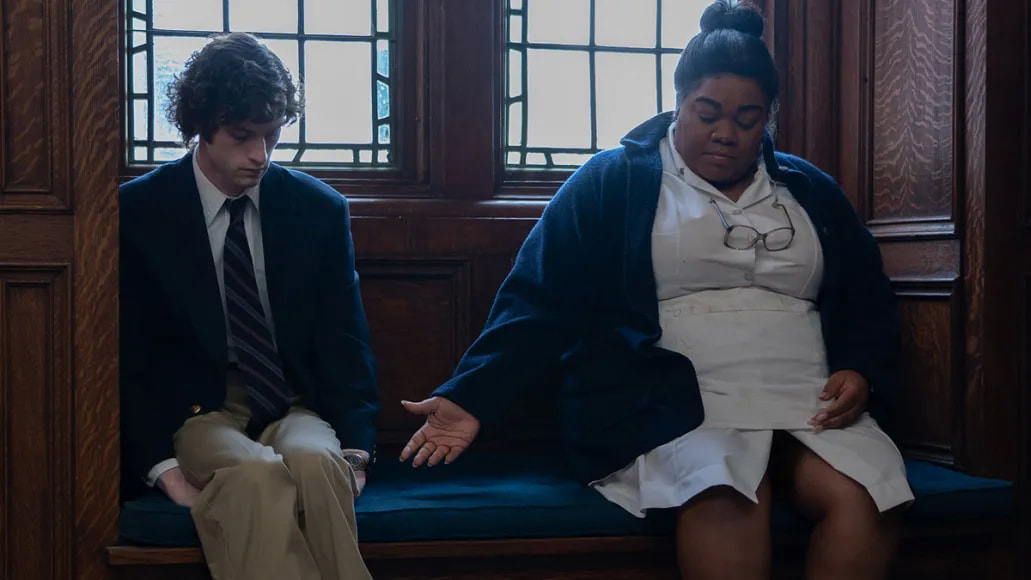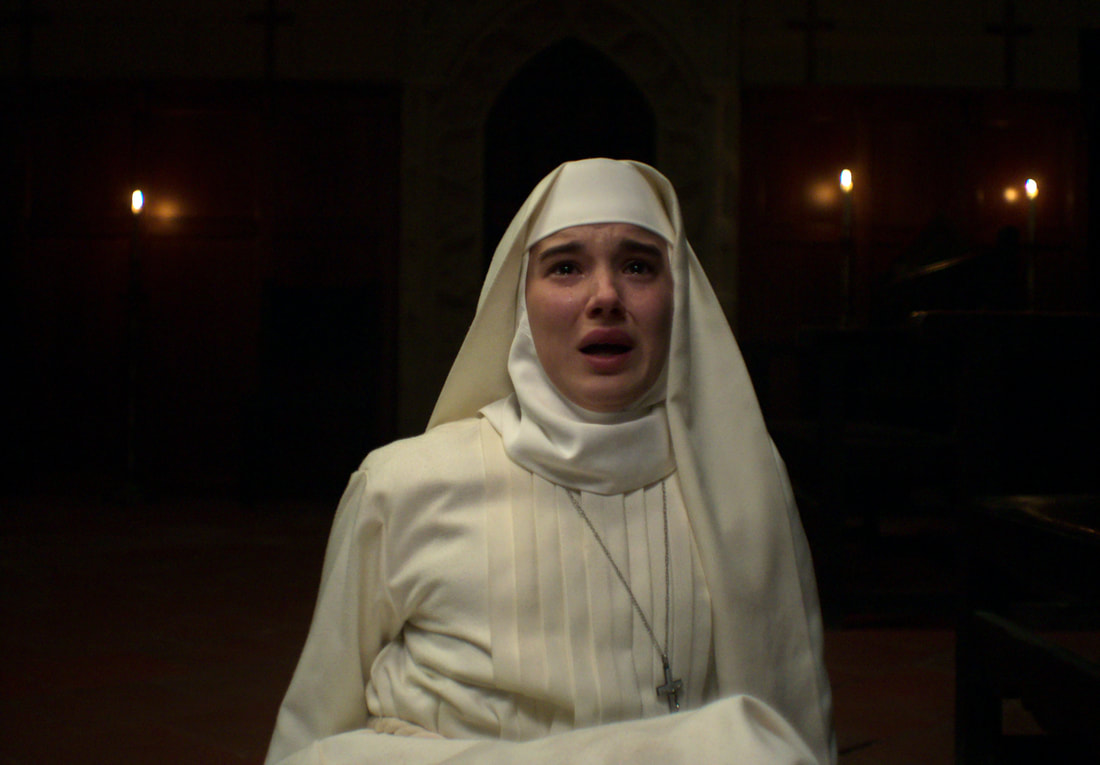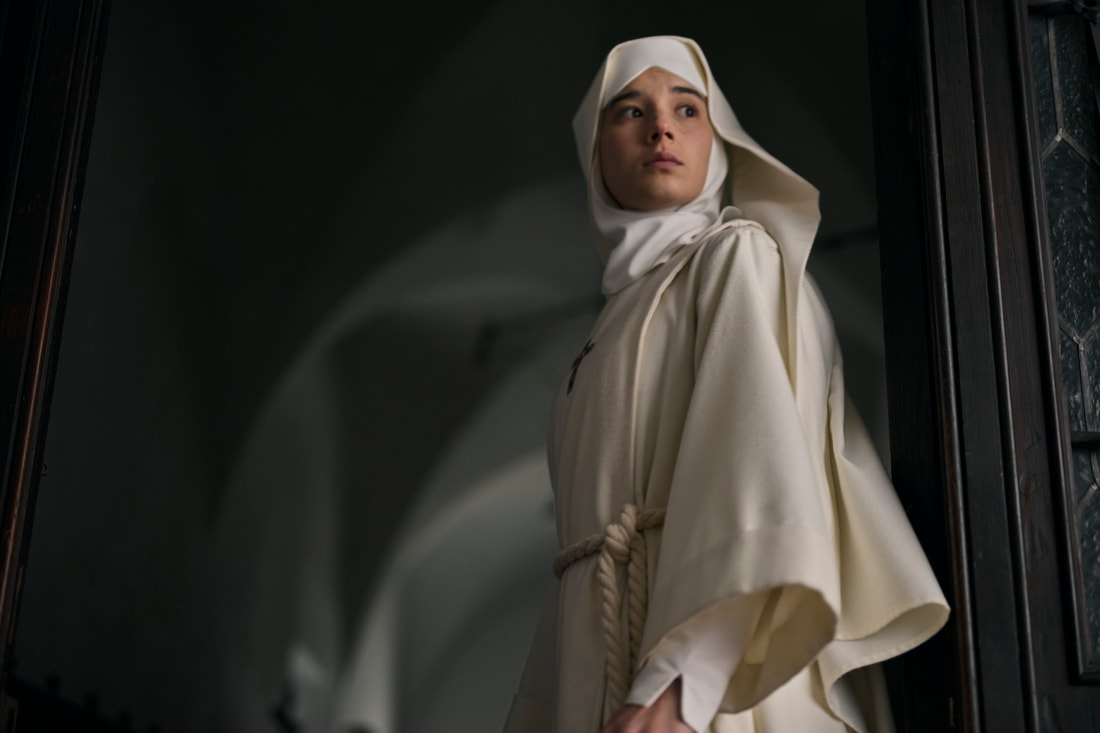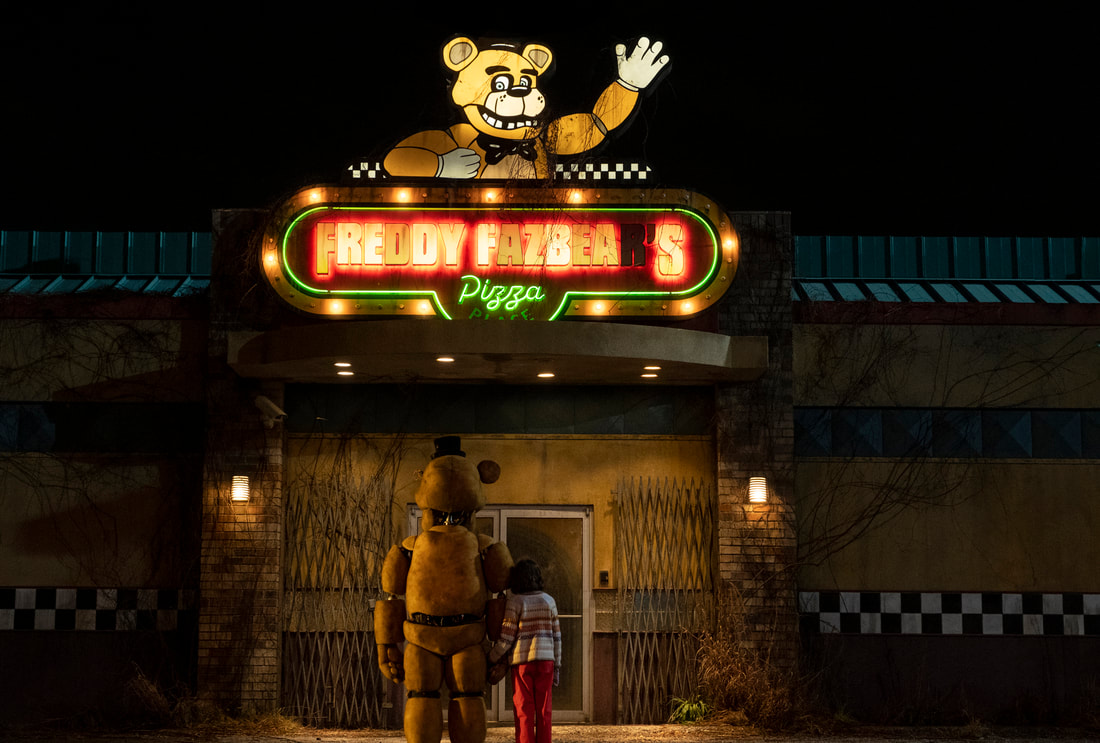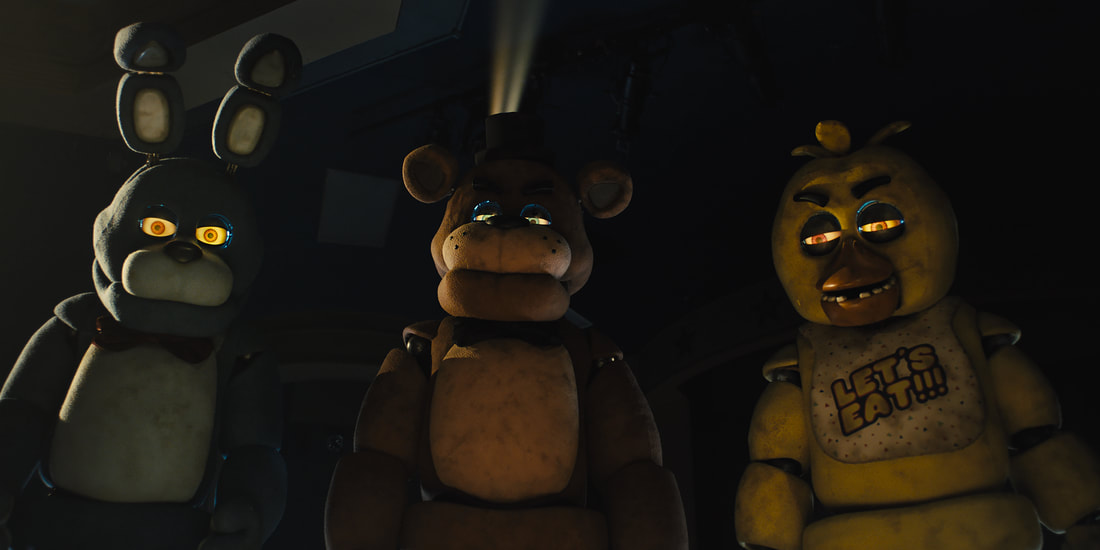|
Review by Sean Boelman
Netflix is behind a number of original films from around the world, many of which fail to connect with audiences in the US. Mélanie Laurent’s action flick Wingwomen seems like it may be the exception to that rule thanks to it being elevated by strong performances from Adèle Exarchopoulos and Laurent herself.
The movie follows two professional thieves who want to retire, only to find themselves in over their heads when they are forced to take one last job. Narratively, Wingwomen is straightforward, following the usual tropes of the “one last job” arc — only with the mission feeling even more insignificant than usual. Instead, what will get viewers invested in the story is the dynamic between the film’s two leads. Like virtually every other aspect of the movie, hardly anything about their arcs is original or even atypical. However, thanks in no small part to some committed performances, they’re nonetheless easy to root for. As is likely a surprise to no one, the cast is the absolute highlight of Wingwomen. And while female-led action flicks are usually all about ogling their attractive stars, Laurent’s female lens does a great job of turning these cliches on their head. While she does not shy away from the fact that she’s cast several sex symbols (including Adèle Exarchopoulos and Isabelle Adjiani) or her own sexuality, their roles give them more of a chance to show off their acting chops than usual for the genre.
There are clearly some attempts at comedy throughout, but very few of them land. Perhaps the humor was lost in translation, but the situations are hardly ever funny, and the one-liners don’t have much wit, even when compared to some other examples of the genre. Still, despite this, the film moves along at a relatively breezy pace.
As far as made-for-streaming action movies go, Wingwomen has relatively standard choreography. Exarchopoulos does have one action sequence that impresses, but for the most part, it’s stuff we’ve seen done time and time again. It’s a mix of car chases, shootouts, and fights that, while nothing special, is typically diverting. However, the movie does have some strong technical elements, owing to Netflix clearly putting some money into this. The CGI is solid, the editing slick, and the soundtrack energetic. The film has the right blend of stunts and visual effects to give it the feeling of a grand scale — something that so many Netflix releases have been missing these days. Wingwomen is the type of action movie that seems like it was destined to disappear in the ranks of the Netflix library — especially outside of its home country of France. However, thanks to its strong cast that elevates it beyond its relatively plain script, it may not quite be doomed to that fate. Wingwomen streams on Netflix beginning November 1. Rating: 3/5
0 Comments
Review by Camden Ferrell Whether they started reading the comic book in 2003 or started watching the television adaptation in 2021, everybody agrees that Invincible subverts the genre in unique and violent ways. The two-year wait is over, and the show is finally returning for more bloody superhero hijinks. This second season continues to prove why it’s one of the most exciting shows on TV, and it will be a thrill for longtime fans of the comic as well as those experiencing the story for the first time. Omni-Man is no longer on Earth, and Mark needs to adjust to his new status quo. In addition to losing his father and dealing with the guilt of last season’s tragedy, Mark is ready to prove that he is not his dad all while dealing with regular teenage problems like girlfriends and graduating high school. This new season also brings the highly anticipated introduction of Angstrom Levy, an exciting new character that will bring a new dynamic to the series while giving Mark more problems to deal with. The writing of this show continues to be witty and enjoyable more than anything. It still retains the personality that Robert Kirkman had in his comic, but it does a great job of modifying interactions and polishing the dialogue and storytelling. This new season also juggles a lot more from a narrative standpoint, and at times it can feel like certain parts of the story are getting slightly neglected, but this doesn’t impact the quality since it doesn’t feel like a single second is wasted. One of the best parts of this adaptation is how amazing the voice actors were, and this season is no different. Steven Yeun returns as the titular hero, and he knocks it out of the park once again. Of the returning cast members, Sandra Oh stuns as Debbie, and she is given some emotionally heavy material where she gets a chance to shine. This season brings along countless new voice actors to be excited about, but Sterling K. Brown as Angstrom Levy is already one of the best castings they’ve had so far.
Like the first season, this newest season follows the original storyline very closely, so fans of the comic book series will likely see many things coming. However, this does not at all undermine how brilliantly violent and exciting these episodes are. Even as someone who has read the entire series, I found myself captivated by every episode as if I was experiencing this story for the first time. Those who are not familiar with the source material are in for many shocking and brutal moments that will have them itching for more. Invincible comes back with a bang in season two. It picks up swiftly with some killer action and superhero antics, but it also reflects a more mature and emotional side than it had last season. It’s a delight to watch these characters grow in their own unique ways, and one can only watch this season and be grateful that we get to see these crazy events animated beautifully for all to enjoy. Invincible premieres the first episode of season two on Amazon Prime on November 3 with the following 3 episodes releasing on subsequent Fridays with the remaining 4 to premiere in 2024. 4 of 8 episodes have been reviewed. Rating: 5/5 Review by Jonathan Berk At one point in the film Subject, Caroline Libresco says, “We are intrinsically connected to story.” It’s a sentiment that manages to feel both obvious and profound simultaneously. In an age where media is almost always available to us all, we consume stories at record numbers. There is a clear interest in “true” or “real” stories and documentaries — which once brought on the ire of bored history students everywhere — and they have become far more mainstream as a result. An increase in interest means an increase in production, which makes the focus of Subject feel all the more poignant. This film is a documentary about documentary filmmaking that steps back to ask important questions about the process. Directors Jennifer Tiexiera and Camilla Hall explore key ethical questions about the genre that has found itself in a “golden era” of sorts, largely due to streaming services. Through interviews with former subjects of big-time documentaries and people involved in the filmmaking process, Subject explores important ethical questions about the medium. Ultimately, the premise of this movie is undeniable. A meta-commentary on the very thing being made is far too compelling to not watch. Even while the film is questioning why audiences are drawn to things like this, it is providing the very type of content it is investigating. However, the film wants the audience to do a lot of the heavy lifting. For the most part, the film does a great job of raising many of the questionable topics the medium presents: compensation for the subjects, who gets to tell these stories and representation in general, the connection of the filmmaker and the “subject”, the objectivity of the filmmaker, life after the premiere, and the concept of consent and exactly what the “subjects” are consenting to. It doesn’t propose any answers, nor does it feel like it comes to a final stance on whether we should continue to make documentaries or not. Instead, audiences are left with the burden of choosing for themselves where they stand on all of these issues.
The main documentaries referenced and those films key participants included in this movie are The Staircase, Hoop Dreams, The Wolfpack, Capturing the Friedmans, and The Square. There are many other documentaries referenced, but these five feature interviews with subjects and — in the case of Hoop Dreams and Friedmans — the filmmakers. The weaving of these films and their investigation of the impact the documentary had on their lives both during and after the release is inherently interesting. As stated, we are drawn to stories, and for these people, we are drawn to their stories yet again. Fans of the genre will have likely internally grappled with these questions many times already; however, Subject making it the focus feels necessary. It’s impossible to watch something like The Wolfpack and not question if the filmmaker should be injecting more assistance into the lives of these siblings and their mother, who are trapped by a cruel father/husband. Whether news reporting or long-form documentary filmmaking, there is an undeniable responsibility to handle these “true” stories with care. These are people, after all, not inanimate objects at the end of our microscopes. Subject will be in theaters on November 3. Rating: 5/5 Review by Cole Groth The Hell House franchise has been a rollercoaster of quality. The original installment was a great new found-footage movie with an exciting premise and some good scares. The first sequel is probably one of the worst horror movies ever made. The third entry, though, picked up a bit and wasn’t quite as bad as its predecessor. Fortunately, Hell House LLC Origins: The Carmichael Manor is much more in line with the original. With a quick pace, good scares, and believable characters, it might be the best film in the series. Like the rest of the series, this film is shot like a documentary. Intercut with the found footage are talking head interviews about the wild disappearances of the film’s subjects. A common element in any found-footage movie is scares placed in the corner of frames, something the Hell House franchise loves to lean into. Typically, this series plays too heavily into scares like that, but they’re reasonably scarce in this one. Expect lots of yelling, confusion, and other elements you expect from this type of movie. At the beginning of The Carmichael Manor, we’re told the results of what we’re about to watch. Couple Margot (Bridget Rose Perrotta) and Rebecca (Destiny Leilani Brown) are internet investigators. Tasked with the daunting challenge of exploring the Carmichael Manor, where several grisly murders happened in the eighties, the two, along with Margot’s brother (James Liddell), stay for four nights in an attempt to solve the murders, only to go missing themselves. Over the film, we see the insanity in the manor, all captured by the victims themselves. Writer-director Stephen Cognetti has stayed with the series since its beginning. His writing skills and the quality of actors he puts in his films have drastically shifted from film to film. The fourth entry features the strongest script and best performances. Perrotta and Brown are surprisingly fantastic and make for some of the most likable and authentic protagonists in a found-footage movie. Most films of this genre — especially in this series — focus on annoyingly loud people, the removal of which makes this a lot better.
To all my loyal followers, you’ll notice that my reviews are much harsher on Shudder films than other writers. Usually, I don’t find their movies scary; if they are scary, they end up being highly unpleasant watches. Fortunately, The Carmichael Manor stands out as a consistently satisfying and scary horror flick. During the regular, unscary scenes, the pacing is fast enough not to feel dragging. When the third act begins and the insanity peaks, the scares are powerfully uncomfortable and well done. Even though the characters’ fates are known from the beginning, it’s still surprisingly riveting to see what will happen next. This immense praise isn’t to say the movie is without flaws. Cognetti’s story is hard to follow, and it seems the only thing that will save the plot is a complete reset in the future. There’s a whole flashback subplot that’s pretty confusing, too. Looking past a confusing story, you’ll find a great new horror movie in Hell House LLC Origins: The Carmichael Manor. This series seems to be on the right track for the first time since the first film. There’s a lot of potential in the franchise, and hopefully, Shudder will push through with a sequel that manages to be the same quality. Hell House LLC Origins: The Carmichael Manor releases on Shudder on October 30. Rating: 3.5/5 Review by Joseph Fayed Priscilla is the latest Sofia Coppola feature to have a female protagonist trapped in the ever so isolating lifestyle of the rich and famous. This time she tells the story of Priscilla Presley, and using a similar formula as she has in the past, Coppola keeps you engaged in this slow burn of a biopic. When she was 15 years old, living on a military base in Germany with her family, Priscilla Beaulieu (Cailee Spaeny) met 25 year old Elvis Presley (Jacob Elordi). The film follows the next decade of their relationship, and how Priscilla became inserted into a world she knew absolutely nothing about. As her life changes, Priscilla must decide what she wants, while also considering the impact on her world famous husband and how easily their lives can fall apart. The film is told largely from the perspective of Priscilla and gives her more agency in several ways — for, example, by not including Elvis music (even if part of the reason is that the production was not granted permission to include his songs). Elvis was heavily focused on his career and is absent for a significant portion of the film. Priscilla, in the meantime, must come to terms with her new surroundings. She explores her new reality like any other teenager would have. The most sensationalized aspect of the relationship between Elvis and Priscilla was their significant age gap. Unlike Elvis, where this detail was seemingly overlooked, Sofia Coppola dares to plant the seed that the king of rock and roll may have been at fault here. There are moments in the film where Elvis lashes out at Priscilla and gets violent with her. His team — with whom he spends more time on the road than he does with Priscilla — acts as yes men and doesn't disapprove of his actions. The downfall of their relationship isn't painted as some takedown of Elvis, but a growing discontent on behalf of Priscilla. It is obvious that she, like many other celebrity marriages, lost touch with her happiness once the honeymoon phase of their relationship was over. What followed was suffering in silence... something that the claustrophobic nature of the film captures beautifully.
Coppola is at her A-game once again when it comes to cinematography and set design. It's hard to describe how intimate shots are set up when they focus specifically on Elvis and Priscilla, versus the wide angle shots that almost hide our characters in a backdrop of pastel colors. Cailee Spaeny and Jacob Elordi have great chemistry with each other and don't try to outact each other by impersonating Priscilla or Elvis. They look and sound like their characters, without having to go into theatrics to prove their transformation. Priscilla mostly avoids falling into familiar tropes that tend to tank biopics. Given that this one was produced by Priscilla herself, she was clearly able to give her say in the matter. Whether it's the accusations of Elvis grooming her or his own infidelity, nothing serves as a dramatic turn of events until the marriage dissolves. The need to reclaim oneself doesn't happen after a particular sequence of events, and thankfully, the film doesn't act like the story needs to be told that way. It isn't flashy like Elvis was, nor does it focus on making a star a star. Rather, it settles for an intimate portrait of the woman who was by his side for so many years. The lonesome tone of this may be off-putting to some, but as an outsider looking into this relationship, it feels like the film consistently covers how Priscilla always felt she was on the outs too. At least Priscilla was able to find comfort in her bottle of Chanel No. 5 perfume, as would I. Priscilla is now playing in theaters. Rating: 5/5 Review by Cole Groth Have you wondered what comes after death? Of course you have. The concept of life after death is foundational to religion, and it’s one of those few things in life without true explanation. Angel Studios looks to explain the thought process of what happens after death in their faith-based documentary, After Death, which explores near-death experiences. It does a remarkable job of appearing as a scientific and well-intentioned documentary, and for the most part, it is. Unfortunately, it falls into an agenda by the end and loses a lot of the goodwill it starts with through preachy appeals to Christianity. After Death gathers dozens of well-documented survivors of near-death experiences. Raymond Moody, Michael Sabom, Don Piper, and Mary Neal make up just a few of the reputable subjects in this documentary. It’s a functionally simple film that brings people together to talk about their near-death experiences, basking in their thought processes. We learn about how common these experiences are, what they can tell us about the human brain, and how the field of psychology has changed because of these experiences. I’m not particularly religious, so I’m naturally cautious of any faith-based documentary, as they tend to turn into propaganda-ridden and fact-less films. In a medium all about facts, that’s just about the worst thing you can do. Because of this skepticism, I made sure to do some research of my own while watching this. Rest assured, this is a primarily scientific documentary. There’s plenty of research to back up claims of near-death experiences, and with that in mind, it’s mighty interesting. Getting a glimpse into the stories of people who experienced these insane things with a close brush to death opened my eyes to psychology and my views on death. Each person’s story is recreated with actors. Sometimes, it works pretty well. Other times, it winds up being needless and cheesy. There’s something a little bit stupid about watching a person describe an emotional low in his life — all while some actor overacts in some sappy scene. The portrayals of these out-of-body events are done in a pretty exciting way, though, designed to be trippy and interesting. Overall, the production value can be seen as a mixed bag. Some polish would’ve made it feel more like a theatrical release, rather than a Lifetime-esque crime/thriller.
There’s nothing more annoying than having an agenda pushed on you. If you’re planning on seeing this in a theater, you’re probably already a Christian and will love the come-to-Jesus moments that the interviewees go through. Now, this film doesn’t go as far as to proclaim Jesus as the one and only savior. Similar to Sound of Freedom, while the religious or political motivations may be clear of the creators, it’s not so egregious that only Christians can watch this. There are some interviewees who reveal themselves as hardcore born-again Christians, and these people are easily the weakest ones interviewed. It feels like a bait-and-switch when these people all explain they became Christians after seeing God in the afterlife, and it manages to be a pretty eye-rolling way to end the documentary. Throughout the credits, the filmmakers beg audiences to participate in a pay-it-forward thing, where you can pay for other people’s tickets. It’s a smart marketing strategy because rich audience members can spend a disproportional amount of money on tickets and let dozens of other people watch the film in a theater. I can’t help but think that the whole thing is a bit of a grift, though. The film isn’t presented to be nearly as important as the subject matter of Sound of Freedom, so why is a huge QR code shown on screen throughout the credits? After Death has a bit of a credibility issue. To be clear, the documentary is still good for the most part, but without the religious stuff, it would’ve been leagues better than the final result. After Death is playing in theaters now. Rating: 3/5 Review by Jonathan Berk Fans of Letterkenny probably knew all about the elusive Shoresy before season 1 of the Canadian comedy's spin-off. Creator and star Jared Keeso crafted a foul-mouthed hockey player who tormented Reily and Jonesy, but whose face audiences never saw. That humor unsurprisingly carried over into the spinoff series — but what probably surprised everyone was the sheer heart the show and character brought. Season 2 continues in this fashion, giving Shoresy (Keeso) and his teammates the opportunity to explore various elements of their characters. Add in a compelling hockey storyline, and the notably funny moments we’ve come to expect from Keeso created content continue to make this spin-off a standout. The season starts with a quick update of what’s happened since the previous season, and it appears that Shoresy has lived up to his promise of never losing again. The Bulldogs have found success, and we join them during a potentially record-breaking winning season. We’re reminded that when Shoresy first joined the team, it was likely to fold, and he fought to keep it alive. Now, the team is thriving, and the tension is built around how the guys keep focused with their newfound popularity. Shoresy is hands-down the greatest shit-talker out there. The show gives us great montages of Shoresy just cracking jokes at the expense of other characters. A great one in episode 2 features Shoresy “encouraging” his teammates while they’re in the gym. He is either dissing their form or offering other, more challenging exercises they could be doing. They seem unphased by the relentless onslaught of words spewing out of their captain's mouth while he just sits and watches them break a sweat. These are a highlight of the character, and there is no shortage of this humor. When you step back and look at the structure of this series, it becomes all the more impressive. There are only six episodes per season — running around 20 minutes an episode. Nonetheless, almost every character gets something to do, a storyline to develop, and some degree of an arc. They aren’t all complex, but we get a real sense of who these guys are — at least in an archetypal way — and the show plays into that.
The characters we started to get to know and love in season 1 — Nat (Tasya Teles), Sanguinet (Harlan Blayne Kytwayhat), Hitchcock (Terry Ryan), Michaels (Ryan McDonell), Ziigwan (Blair Lamora), Miigwan (Keilani Elizabeth Rose), Dolo (Jonathan-Ismaël Diaby), Michaels (Ryan McDonell), Fish (Jacob Smith), Goody (Andrew Antsanen), Frankie (Max Bouffard), and the Jims — are all, somehow, developed. That’s next to our main character and his interactions with them all, mind you. It’s kind of a miracle that such a compact show can deliver so much while also playing around with its style. The presentation for most of the series is understandably straightforward camera work. However, there will also be some innovative stylistic flourishes. While fights break out during one hockey game, the camera cuts to a point-of-view perspective from the Bulldogs' bench, putting the audience in the skates of the team. There are music-led “hero” sequences that break the flow of the show to give us an almost Spike Lee style, staring-down-the-barrel-of-the-camera interlude, just to remind the audience how cool these guys are… or at least how cool they think they are. These elements are sprinkled in to break tradition in a way that fits the vibe of the show. Substance takes priority, but the team behind the production know how to make the show “feel” cool. Shoresy is undoubtedly one of the better spin-off series out there. Keeso took a character who was nothing more than a faceless punchline dispenser and turned him into a lovable screw-up. He has passion pouring out of his foul-mouthed hockey player, which is equal parts inspirational and endearing. At the time of this writing, I’ve seen five of the six episodes for season 2, and frankly, I can’t wait for the finale. Fans of the series will be pleased with the continued standard of quality, and the direction the story seems to be taking us. The entire season 2 of Shoresy will be streaming on Hulu on October 27. Five out of six episodes reviewed. Rating: 5/5 Review by Tatiana Miranda Movies and shows set in the 1970s have existed since, well, the 1970s. Yet, even with the acclaim of a few recent '70s-based pieces of media, such as Licorice Pizza and Daisy Jones and the Six, they have the same aesthetic representation of the era as a tacky Party City costume. This is not the case with Alexander Payne's film The Holdovers. Set in 1970, the movie centers around a group of students residing at the prestigious boarding school Barton Academy over winter break. Chaperoned by the widely hated history teacher Paul Hunham and cook Mary, there is eventually only one student remaining, the outspoken but compassionate Angus Tully. Paul, played by Paul Giamatti, is the kind of role one would expect the late Robin Williams to portray. This is probably a result of the movie's similar setting and plot to beloved films such as Good Will Hunting and Dead Poets Society. Much like the younger leads of those films, Dominic Sessa's character, Angus Tully, is rebellious and perhaps a bit emotionally stunted due to his family issues. Because of this, The Holdovers seems a bit cliche at first, yet the film's adherence to '70s aesthetics and film techniques makes it clear that its simplicity is meant to be an ode to the emotional dramas of the past — not a replica. While The Holdovers is pretty standard in terms of its characters and emotional drivers, its commitment to embodying a movie both filmed and set in the 1970s makes it a masterclass in effective world-building. From the period-accurate costumes to the grainy visuals, which are thanks to it being shot on 35mm, there is not a moment where the film comes off as cheesy and unrealistic — even with the soundtrack featuring songs from modern artists such as Damien Jurado and Khruangbin. The Holdovers feels like a classic emotional drama in so many ways, namely its comedy. The characters' deadpan deliveries and outlandish actions inject personality into an otherwise dismal film. Still, the funny interactions don't diminish the seriousness of some of the subject matter. In something that tackles subjects such as racism, classism, and mental health, humor is much needed to balance out the dramatic aspects.
Out of the three lead performances, Sessa is perhaps the standout as he breaks into film with his performance in The Holdovers. He perfectly portrays a wisecracking, tenderhearted teen dealing with the disappointment of being stranded over the holiday break. This is not to say his character isn't sometimes contradictory, as it's sometimes unclear whether he wants to excel at Barton or get kicked out. Still, his emotional outbursts cause the other characters to reevaluate their own emotions and grow as the film progresses. Just in time for the holiday season, The Holdovers is an entertaining slice of nostalgia that is bound to be a favorite among Thanksgiving Day moviegoers. Even more than that, though, it's a testament to the creativity of Alexander Payne, and that sometimes simplicity is key. The Holdovers releases in theaters on October 27. Rating: 5/5
Review by Sean Boelman
Horror spin-offs are all the rage these days, taking characters from moderately successful horror movies and using them to create franchises. Just look at the Conjuring Universe — with several spin-offs based on the franchises’ villains. Billed as “from the world of Verónica,” Paco Plaza’s Sister Death is incredibly dull, mostly because there’s not enough material to justify this as a feature.
The film serves as a prequel to Verónica, telling the story of the blind elderly nun to whom the possessed teen turned to advice. Set nearly half a century before the events of its predecessor, Sister Death follows the character as she joins a school to teach young girls — only to experience terrifying visions of the supernatural. Although Verónica was incredibly simplistic in terms of its narrative, it worked well because of how atmospheric and terrifying it was. Unfortunately, Sister Death is nowhere near as scary as the movie to which it owes its existence. There are some suddenly violent images throughout, but they are never particularly frightening — nor do they build to anything in a way that makes the conflict feel threatening. It doesn’t help that the film feels like any number of convent-set horror flicks of the past many decades. Plaza deals in the same imagery you’re used to seeing in any Catholicism-inspired terror — mostly burning or bleeding Christian iconography. Jorge Guerricaechevarría’s script does nothing to add to the formula, nor does it add meaningfully to the mythos of this would-be franchise.
It’s a shame because Plaza is a skilled director, and he managed to attract some talented collaborators to work with on this project. The production design by Laia Ateca and cinematography by Daniel Fernández Abelló create some beautiful images that give the movie the potential to be visually hypnotic, but the writing is so underwhelming that it will immediately draw viewers out of the film.
Ultimately, what Sister Death is missing is a purpose. If this weren’t a streaming release destined to disappear in the sea of content on these services, one would almost accuse this of being a shameless cash grab, trying to milk something with little franchise potential into a usable IP. It truly feels like there is no reason for this movie to exist, as it tells a story in 90 minutes that Verónica managed to effectively tell in a single scene of exposition. It’s also worth noting that movies like this are made or broken by their lead performances. Unfortunately for Sister Death, actress Aria Bedmar does not have what it takes. Of course, not all of the blame lies on her shoulders — one can’t do much with an incredibly bland and generic character — but Bedmar is simply never believable in the role. You never feel her fear, and worse yet, you never feel her faith. All in all, Sister Death feels like nothing more than a massive waste of time. It’s easy to see that Guerricaechevarría was really grasping at straws when writing this. Although, who should really be surprised? It’s a feature length origin story about a character who only had a few minutes of screen time in a moderately acclaimed cult classic where her origin was already explained. It’s competently made, but that does not result in an experience that is even remotely satisfying. Sister Death streams on Netflix beginning October 27. Rating: 2.5/5 Review by Adam Donato Blumhouse is a pillar of modern blockbuster horror movies — especially when it comes to their franchises. Five Nights at Freddy’s has been floating around for years before it finally got its opportunity. It’s an interesting horror demographic, as it appears targeted at older kids. YouTube certainly helped popularize the franchise and has its DNA all over this new movie. Starring Josh Hutcherson and Matthew Lillard, this video game adaptation is looking to appeal to existing fans, while also remaining hip to casual horror fans. With a fairly unknown director in Emma Tammi, does Jason Blum have his next hit horror franchise in Five Nights at Freddy’s? The press screening was packed to the brim with fans of the game. People were wearing merchandise, and it was surprising to see how many children were present. Without spoiling anything, there were several moments in the movie that had the audience erupt with joy. From an outsider's perspective, it was very hard to see the appeal. The movie is dogwater. The story totally misunderstands what seems to be the appeal of the franchise. What should be a cheesy horror romp is filled with child displacement and never-ending trauma. It’s encouraging that the story attempts to have characters with emotional depth, but we’re talking about the evil Chuck E. Cheese parody. With a runtime of 110 minutes, there’s plenty here that could’ve been cut. It’s a shame, too, because two years ago there was a very similar movie in Willy’s Wonderland. That movie understood the B-movie assignment and accomplished so much more than Five Nights at Freddy’s -- and in just under 90 minutes. What’s most disappointing about this movie turning out to be a dud is that the effects were quite good. The Jim Henson company worked on the animatronics for this film, and it’s easily the crowning achievement of this feature. This aspect feels like the hardest part about realizing this concept, so for that goal to be accomplished and for the surrounding elements to be so poor, it feels like a wasted opportunity. Still, the practical effects are a feather in its cap.
The characters were obvious and weird. Josh Hutcherson is unlikable as this down bad security guard who just wants to take care of his daughter. This role is not a welcomed return for the once-frequent child star, as he just has not developed into a compelling lead. Matthew Lillard is a welcomed return, though, but his character is given such little screen time. Elizabeth Lail, star of Countdown, is the most out of place character here. She acts as the love interest and voice of reason, but her inclusion is so awkward and forced. There’s also a weird subplot where the aunt is trying to steal custody of Hutcherson’s little sister. Cut it. Cut it all. Hardcore fans of the franchise may be satisfied with just seeing their favorite characters represented so well on the big screen, but everything with humans is a snooze fest. It was a baffling direction to take this movie in with all the lost child drama. A horror concept that is so inherently childish should be more fun/scary and less depressing. Hopefully, the day and date release on Peacock will stymie the box office enough to prevent a continuation of this garbage. Rest in pieces. Five Nights at Freddy's hits theaters and Peacock on October 30. Rating: 1/5 |
Archives
July 2024
Authors
All
|
|
|
disappointment media
Dedicated to unique and diverse perspectives on cinema! |

